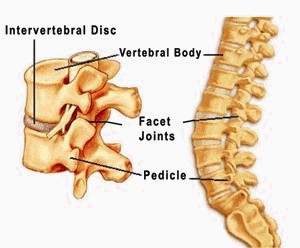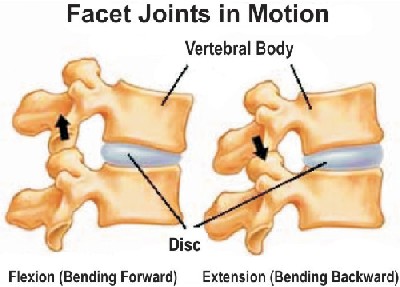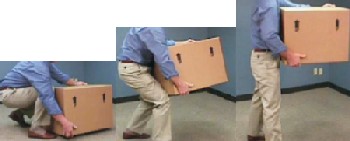Protect Your Back!
Occupational Health and Safety
The spinal column: A more or less solid structure
Doing things as simple as carrying a parcel, driving your car or bending over to tie your shoes can cause you to feel sudden back pain, as if you've been stabbed in the back. Your back locks up and you're immobilized, unable to straighten up or make the slightest movement. In just these few seconds, you have joined the thousands of others who suffer from back pain.
A few weeks of rest is usually all it takes for your back to recover but sometimes more drastic treatments are required, such as traction and surgery. Some people never recover. They are left with a permanent disability and from then on are unable to perform any strenuous work involving their spine.
Your spinal column is truly an architectural marvel. It is made up of vertebrae that are able to support more than one hundred times their own weight. These vertebrae are separated by discs flexible enough to allow for flexion and rotation in all directions, often under the stress of a heavy load. The vertebrae are concave to allow the nerves and blood vessels to pass along the spine and they are held in place by a group of structural muscles that are designed to function throughout your life. But your spine is not solid as a rock.

When you handle a heavy load, the force exerted by your hands is transmitted to the floor through your wrists, elbows, shoulders, trunk, hips, knees, ankles and feet. In this interconnected system of bones and muscles, the trunk and more specifically the lower back is the weakest link. It is not surprising, then, that low back injuries (LBI) account for one quarter of all occupational injuries and two thirds of repetitive work injuries.
Ordinary back pain
Most backaches are caused by simple muscle irritation. The pain is localized in the neck, upper back or lower back (lumbago), or spreads down into the buttock and thigh areas (sciatica).
Unexpected or sudden events
When you lose your balance, trip over an object or fall down, or when you are struck or grazed by an object, you jump and react in order to avoid an accident. These bodily reactions can be very damaging to your back. To avoid any onset of back pain, make sure that your work environment is free of these kinds of obstacles.
- Repair damaged floors.
- Pick up garbage and debris that could get in your way.
- Avoid handling objects on stairs.
- Install automatic door openers.
- Do not try to stop a falling object.
- Always use proper material handling equipment.
Occasional lifting of heavy loads
"Back strain" generally affects those who are not used to lifting loads, and occurs when the load is too heavy, unusually light or when it is held onto. These LBI are generally of muscular origin but they can also be very serious if you are bent over too far or if you must rotate your lower back while in a bent position. The discs can be crushed, protrude (hernia) or tear.

- Identify the job task that puts the most stress on your back and then either eliminate it or replace it.
- If you are not used to exertion, do not lift objects over 23 kg.
- Ask for assistance if loads are too heavy.
Handling loads at your maximum physical capacity
A strain can also occur when you are working at your maximum capacity. Some people are stronger than others, while others are not as strong. Never attempt to handle a load that "you" find too heavy and never overestimate your strength, even if you are used to doing physically strenuous work.
- Never exert yourself unnecessarily.
- Do not challenge yourself.
- Do not consider yourself stronger than someone else.
- Increase your muscle strength through regular physical exercise.
- Increase your aerobic capacity through resistance exercises.
Chronic back pain
Chronic LBI is different from ordinary back pain and is frequently seen in individuals performing repetitive work. The discs and portions of the vertebrae gradually deteriorate and irritate the nerve roots exiting from the spine. In the early stages, there are no symptoms: no pain, no stiffness, no discomfort. Not even x-rays can detect a disc that is starting to degenerate. Later, pain develops more or less suddenly and spreads to the adjacent structures depending on which nerves are irritated or impaired.
Repetitive lifting
Repetitive lifting is the most common cause of chronic LBI. The risk of back pain is higher if you frequently lift loads, if you carry loads over long distances, if the load is heavy, if you carry a load far out in front of you or pick up a load from the floor, and if you must extend or stretch one or both arms out to reach the load or bend or twist while carrying the load. There are many ways to prevent chronic back pain.

- If possible, completely eliminate repetitive work.
- As much as possible, automate jobs involving repetitive tasks.
- Use mechanical handling equipment, such as hand trucks, lift trucks and conveyors.
- Reconfigure workstations in order to avoid awkward positions.
- Decrease the weight of objects handled.
- Add grips to objects being handled.
- Use personal protective equipment, such as belts, braces, leg guards and anti-fatigue matting.
- Learn and apply safe lifting techniques.
Other types of repetitive handling
Pushing, pulling, grasping, changing the direction of a moving load, throwing or even just regularly carrying loads can also cause chronic LBI by exerting stress on the spine and back muscles. Here we find the same causal factors as those described for lifting but the height of the work area seems to be the determining factor.
- Adjust the height of conveyors to the waist level of tall persons (approximately 100 cm); shorter individuals can stand on a platform.
- Lift and set heavy objects down on a work surface at least 50 cm high.
- Keep the top shelves of a shelving unit for lightweight objects. The top shelf should never be higher than 175 cm.
Prolonged sitting or standing
Sitting day after day in front of a desk or computer screen can result in neck pain or upper back pain, as well as low back pain. Neck and upper back pain is generally muscular and disappears after an ergonomic adjustment of your workstation: lowering the screen, adjusting the chair, adjusting the keyboard height, etc.
However, LBI are caused by a slow deterioration of the discs due to pelvic tilt and rounding of the spinal column when you are sitting down. These injuries are even more likely to occur if you must handle heavy objects while sitting.
- Make sure you have a proper chair.
- Adjust the back rest to angle backwards between 110 degrees and 120 degrees and place a 5 cm thick pad at the small of your back.
- Avoid stretching your arms out to reach for objects. Stand up.
Operating a vehicle
When associated with continuous vibrations from the road, sitting is very hard on the spine. LBI are caused by rounding of the back and also by fatigue and softening of the discs and ligaments attached to the muscles that are subjected to such vibrations.
- Try not to keep your feet in the air. Rest them frequently and, if possible, keep your heels on the floor.
- Support your back by adjusting the angle and height of the back rest.
- Install shock absorbers underneath the seat.
- Do not jump out of the cab. Use the steps.
- During breaks, do gentle stretches, relax your back muscles and above all, go for a walk.
Heavy work
Some jobs require a metabolic output that exceeds the normal limit of most individuals: hot environment, quick movements, work using all four limbs, handling heavy loads, climbing stairs, etc. We do not yet fully understand why heavy work results in more back pain (lumbago, sciatica and chronic LBI) than light work, but certainly one reason is postural stress and fatigue.
- Lighten the workload.
- Avoid static loads.
- Ventilate the work area to lower the temperature.
- Increase the number and length of breaks.
- Allow more space for movement.
- Wear lightweight clothing.
- Do a muscle warm-up before starting to work.
Other problems associated with back pain
Too often we forget that backaches rarely occur on their own. Repetitive handling can also cause other types of injuries. Many times, back pain is accompanied by lacerations, crush injuries and fractures caused by uneven surfaces, falling objects, a fall by the operator and impacts. Musculoskeletal stress is also harmful for other joints and muscles in the human body, mainly at the neck, shoulders, elbows, knees, hips and fingers. Fatigue can also be a factor leading to increased heart rate and blood pressure and sometimes respiratory problems.
What you can do
Relatively speaking, back pain is more frequent in women and the elderly. There is nothing much we can do about it. Still, you can reduce the risk of back pain if you stay in shape through regular physical and aerobic exercise, increase your muscle strength, especially the abdominal muscles, and adopt proper lifting techniques. But make no mistake: it is primarily by reconfiguring your workstation, lightening loads, slowing down the work pace and using handling equipment that you will most likely reduce the risk of back pain.
You can order additional printed copies of this publication, indicating catalogue number LT-006-07-07, from:
Enquiries Centre
Human Resources and Skills Development Canada
140 Promenade du Portage
Phase IV, Level 0
Gatineau, Quebec
K1A 0J9
Fax: 819-953-7260
Online: Publicentre - Publication Search
Available in alternate formats, upon request. Call 1-866-386-9624 (toll free) on a touch-tone phone.
© Her Majesty the Queen in Right of Canada, 2007
Cat. No.: L31-95/2003
ISBN: 0-662-67590-8